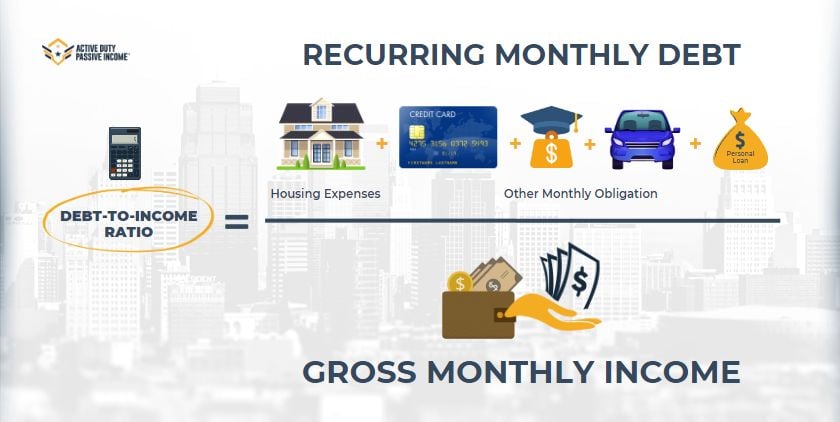VA loan DTI or (Debt-To-Income) ratio is an important ratio in determining your eligibility for a VA loan.
Loan officers upon their attempts to qualify you for a loan will review your Debt to income ratio. Upon the full evaluation coupled with a couple of other factors you will get an understanding with your loan officer of what you will qualify for and in most cases an interest rate that will help you understand what your monthly payment will be.
Let’s explore the guidelines and requirements. Understanding your DTI and how it is calculated long before your actual purchases can absolutely assist in preparation and a higher loan amount! Let’s dive in.

What Is Debt-To-Income (DTI)?
Debt-To-Income (DTI) is a ratio that compares the borrower’s monthly debt payments to their gross monthly income. It’s used by lenders to determine the borrower’s ability to manage additional debt and make monthly loan payments on a home. To calculate your debt to income ratio, add up all your monthly debt payments and divide them by your gross monthly income. An example is $1920/$4200 is 45% debt to income ratio. Lenders use this as a key factor in deciding whether to approve your home loan application or refinance. A lower DTI indicates a lower risk for the lender, which can lead to more favorable loan terms and interest rates to purchase or refinance a home.
Let’s go into some examples
- A good debt to income ratio is typically below 36%. For example, if your monthly debt payments are $1,000 to include your home loan and your gross residual monthly income is $4,000, your ratio would be 25% ($1,000/$4,000). This would be considered a good DTI, as it suggests you have enough income to comfortably manage your debt payments.
- A debt above 43% is an income ratio is typically one that will have a few more questions to go through to assess overall risk. For example, if your monthly debt payments are $2,500 and your gross monthly income is $5,000, your DTI would be 50% ($2,500/$5,000). This would be considered a higher risk ratio in a lender’s eyes, as it suggests you may have difficulty making additional loan payments and may be at higher risk of defaulting on your debts.
Front-End DTI vs. Back-End DTI
When comparing DTI’s lenders use two different metrics. A front end and a back end calculation using two different metrics. Lenders typically like to see 28-36% and loans like the Veteran Affairs backed loans have more wiggle room to raise it to around 41%. This is often something that is a benefit of the overall concept of the VA loan!
Front End DTI
- Front-End debt to income ratio typically includes expenses to do with your home like mortgage principal and interest rates, property taxes, homeowner’s insurance, and any homeowner association (HOA) fees. Lenders use this ratio to assess how much of your income is dedicated to housing expenses. The ideal Front-End DTI ratio is 31% or lower.
Back End DTI
- Back end debt to income ratio includes your monthly debt obligations, including home expenses, credit card payments, car loans, and other loans. Lenders use this ratio to assess your ability to repay your debts, including the proposed mortgage. The ideal Back-End DTI ratio is 36% or lower.
Calculating DTI Ratio for VA Loans
To calculate debt to income ratio for a VA loan, add up all your monthly debt payments, including the proposed mortgage payment, and divide by your gross monthly income. The VA generally requires a DTI ratio of 41% or lower, but some lenders may have stricter requirements for a home loan. This is one of those times when you need to talk to a specific lender about because many lenders will excuse some DTI issues with a VA loan because it is government backed!
For example, if your monthly debt payments including the proposed mortgage refinance payment is $1,500 and your gross monthly income is $5,000, your ratio would be 30% ($1,500/$5,000).
| Monthly Debt | Bill amount |
| Car loan minimum monthly payment | $100 |
| Student loan minimum monthly payment | $100 |
| Credit cards minimum monthly payment | $250 |
| Child support minimum monthly payment | $250 |
| Rent or mortgage for your home | $800 |
| Total monthly debt | $1,500 |
| Monthly gross income | $5,000 |
| DTI ratio | 30% |
What is a good debt-to-income ratio for a VA home loan?
In the example above we broke down the numbers to show what a good ideal DTI is for the military VA home loan. That example would be considered a good DTI for a lender to approve, as it falls below the VA’s maximum DTI ratio requirement of 41%. Special note, if your DTI is over 41% you can also get a co-signer to help out the risk aspect for the lender to approve you. This also applies to refinancing into a VA home loan. Check out our blog on co-signers!
What Is The Maximum DTI For A VA Loan in 2023?
As of April 2023, the maximum VA loan dti ratio is 41%, although some lenders may have stricter requirements or the ability to evaluate your overall debt to meet more stringent requirements. This means that your total monthly debt payments, including the proposed mortgage payment, should not exceed 41% of your gross monthly income.
What If Your DTI for VA Loan Ratio Is Higher Than 41%?
If your DTI is over 41% that is okay, this does not necessarily mean you will be denied. Some lenders will go up to 50% on the VA loan dti ratio, but not so likely on other types of loans due to the VA not backing them, hence reducing the risk on their balance sheets. The VA’s goal is for veteran members to be able to get a home and make home ownership more accessible.
How Do You Lower Your DTI Ratio For A VA Mortgage Loan?
Here is the key to your self evaluation! Prepare for your home purchase.
- Pay off existing debts: Focus on paying off high-interest debts, such as credit cards with high interest rates or personal loans, to reduce your monthly debt payments. You can even perform a balance transfer to a 0% card to further hit the principal paydown.
- Increase your income: Consider taking on a part-time job, freelancing, or seeking a salary increase at your current job to boost your monthly income. This is a great idea, because you can have your same standard of living and use the additional income to reduce some of the debts incurred by your lifestyle.
- Reduce your expenses: Look for ways to cut back on your monthly expenses, such as eating out less or canceling subscription services that are a luxury.
- Avoid taking on new debt: Avoid applying for new loans or added spending on credit cards, as this will increase your monthly debt payments and raise your DTI ratio.
- Consider a larger down payment: A larger down payment on the home will reduce the amount of your mortgage loan and lower your monthly mortgage payment, which can help to lower your DTI ratio.
By implementing these strategies, you can lower your DTI ratio and increase your chances of qualifying for a VA home loan or refinancing into one.
ADPI Pro Tips
- If you have a DTI higher than 41% consider looking at a VA loan option as you have a higher success rate of being qualified with the VA loan DTI ratios.
- Find your DTI ratio yourself by using the calculations above before applying for loans so you know where you stand, you can also reach out to a local bank advisor to help you.
This blog was written in collaboration with our absolutely amazing DoD SkillBridge employee: David









